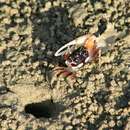en
names in breadcrumbs


The Decapoda or decapods (literally "ten-footed") are an order of crustaceans within the class Malacostraca, including many familiar groups, such as crabs, lobsters, crayfish, shrimp, and prawns. Most decapods are scavengers. The order is estimated to contain nearly 15,000 species in around 2,700 genera, with around 3,300 fossil species.[1] Nearly half of these species are crabs, with the shrimp (about 3,000 species) and Anomura including hermit crabs, porcelain crabs, squat lobsters (about 2500 species) making up the bulk of the remainder.[1] The earliest fossils of the group date to the Devonian.
Decapods can have as many as 38 appendages,[2] arranged in one pair per body segment. As the name Decapoda (from the Greek δέκα, deca-, "ten", and πούς / ποδός, -pod, "foot") implies, ten of these appendages are considered legs. They are the pereiopods, found on the last five thoracic segments.[2] In many decapods, one pair of these "legs" has enlarged pincers, called chelae, with the legs being called chelipeds. In front of the pereiopods are three pairs of maxillipeds that function as feeding appendages. The head has five pairs of appendages, including mouthparts, antennae, and antennules. There are five more pairs of appendages on the abdomen. They are called pleopods. There is one final pair called uropods, which, with the telson, form the tail fan.[2]
A 2019 molecular clock analysis suggested decapods originated in the Late Ordovician around 455 million years ago, with the Dendrobranchiata (prawns) being the first group to diverge. The remaining group, called Pleocyemata, then diverged between the swimming shrimp groupings and the crawling/walking group called Reptantia, consisting of lobsters and crabs. High species diversification can be traced to the Jurassic and Cretaceous periods, which coincides with the rise and spread of modern coral reefs, a key habitat for the decapods.[3] Despite the inferred early origin, the oldest fossils of the group such as Palaeopalaemon only date to the Late Devonian.[4]
The cladogram below results from analysis by Wolfe et al. (2019).[3]
DecapodaDendrobranchiata (prawns) ![]()
Stenopodidea (boxer shrimp) ![]()
Caridea (true shrimp) ![]()
Achelata (spiny lobsters, slipper lobsters) ![]()
Polychelida (benthic crustaceans)
Astacidea (lobsters, crayfish) ![]()
Axiidea (mud shrimp, ghost shrimp, or burrowing shrimp)
Gebiidea (mud lobsters and mud shrimp)
Anomura (hermit crabs and others) ![]()
Brachyura (crabs) ![]()
Classification within the order Decapoda depends on the structure of the gills and legs, and the way in which the larvae develop, giving rise to two suborders: Dendrobranchiata and Pleocyemata. The Dendrobranchiata consist of prawns, including many species colloquially referred to as "shrimp", such as the "white shrimp", Litopenaeus setiferus. The Pleocyemata include the remaining groups, including "true shrimp".[5] Those groups that usually walk rather than swim (Pleocyemata, excluding Stenopodidea and Caridea) form a clade called Reptantia.[6]
This classification to the level of superfamilies follows De Grave et al.[1]
Order Decapoda Latreille, 1802
{{cite journal}}: Cite journal requires |journal= (help) The Decapoda or decapods (literally "ten-footed") are an order of crustaceans within the class Malacostraca, including many familiar groups, such as crabs, lobsters, crayfish, shrimp, and prawns. Most decapods are scavengers. The order is estimated to contain nearly 15,000 species in around 2,700 genera, with around 3,300 fossil species. Nearly half of these species are crabs, with the shrimp (about 3,000 species) and Anomura including hermit crabs, porcelain crabs, squat lobsters (about 2500 species) making up the bulk of the remainder. The earliest fossils of the group date to the Devonian.